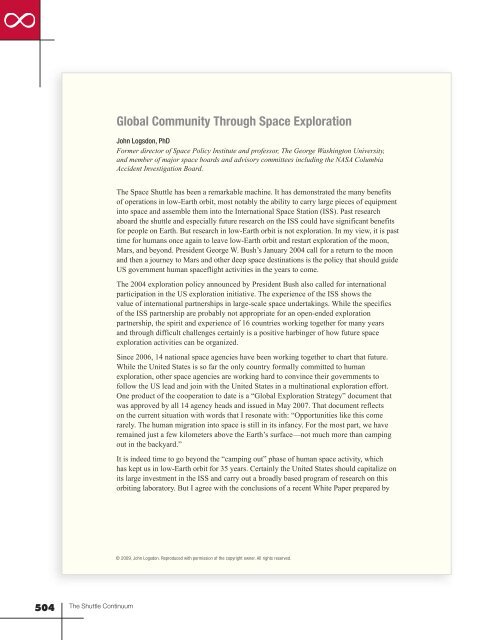Social, Cultural and Educational Legacies - ER - NASA
Social, Cultural and Educational Legacies - ER - NASA
Social, Cultural and Educational Legacies - ER - NASA
Create successful ePaper yourself
Turn your PDF publications into a flip-book with our unique Google optimized e-Paper software.
Global Community Through Space ExplorationJohn Logsdon, PhDFormer director of Space Policy Institute <strong>and</strong> professor, The George Washington University,<strong>and</strong> member of major space boards <strong>and</strong> advisory committees including the <strong>NASA</strong> ColumbiaAccident Investigation Board.The Space Shuttle has been a remarkable machine. It has demonstrated the many benefitsof operations in low-Earth orbit, most notably the ability to carry large pieces of equipmentinto space <strong>and</strong> assemble them into the International Space Station (ISS). Past researchaboard the shuttle <strong>and</strong> especially future research on the ISS could have significant benefitsfor people on Earth. But research in low-Earth orbit is not exploration. In my view, it is pasttime for humans once again to leave low-Earth orbit <strong>and</strong> restart exploration of the moon,Mars, <strong>and</strong> beyond. President George W. Bush’s January 2004 call for a return to the moon<strong>and</strong> then a journey to Mars <strong>and</strong> other deep space destinations is the policy that should guideUS government human spaceflight activities in the years to come.The 2004 exploration policy announced by President Bush also called for internationalparticipation in the US exploration initiative. The experience of the ISS shows thevalue of international partnerships in large-scale space undertakings. While the specificsof the ISS partnership are probably not appropriate for an open-ended explorationpartnership, the spirit <strong>and</strong> experience of 16 countries working together for many years<strong>and</strong> through difficult challenges certainly is a positive harbinger of how future spaceexploration activities can be organized.Since 2006, 14 national space agencies have been working together to chart that future.While the United States is so far the only country formally committed to humanexploration, other space agencies are working hard to convince their governments tofollow the US lead <strong>and</strong> join with the United States in a multinational exploration effort.One product of the cooperation to date is a “Global Exploration Strategy” document thatwas approved by all 14 agency heads <strong>and</strong> issued in May 2007. That document reflectson the current situation with words that I resonate with: “Opportunities like this comerarely. The human migration into space is still in its infancy. For the most part, we haveremained just a few kilometers above the Earth’s surface—not much more than campingout in the backyard.”It is indeed time to go beyond the “camping out” phase of human space activity, whichhas kept us in low-Earth orbit for 35 years. Certainly the United States should capitalize onits large investment in the ISS <strong>and</strong> carry out a broadly based program of research on thisorbiting laboratory. But I agree with the conclusions of a recent White Paper prepared by© 2009, John Logsdon. Reproduced with permission of the copyright owner. All rights reserved.504The Shuttle Continuum
















